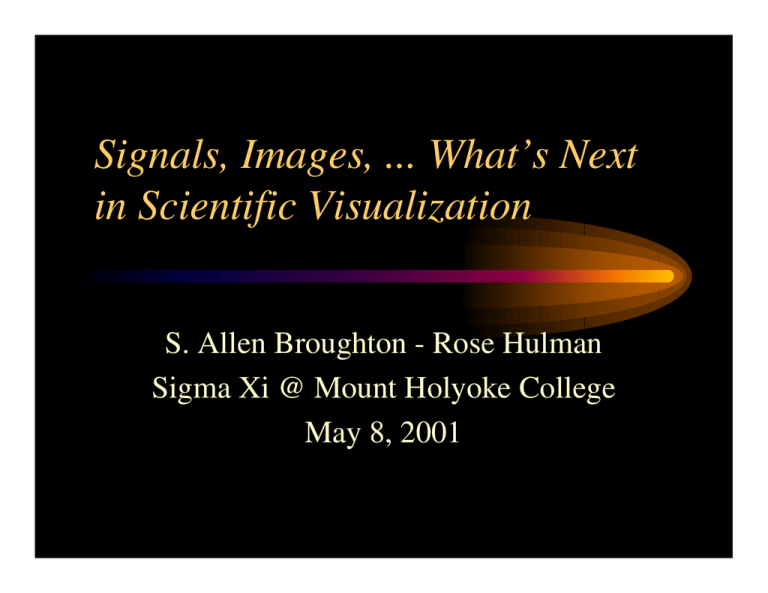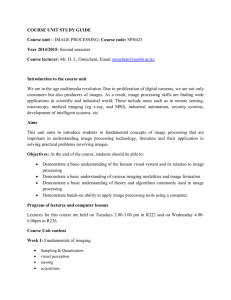Signals, Images, ... What’s Next in Scientific Visualization
advertisement

Signals, Images, ... What’s Next in Scientific Visualization S. Allen Broughton - Rose Hulman Sigma Xi @ Mount Holyoke College May 8, 2001 “A picture is worth a thousand words” • scientists use this principle to convey information about scientific concepts, data, and models • cheap computers and data acquisition tools means enormous amounts of data • how do we interpret it all? • enter the methods of Signal Analysis / Scientific Visualization / Imaging Science Agenda • my point of view • two themes of Imaging Science - Scientific Visualization / Signal analysis • examples of signal, images, ... • examples of visualization concepts and methods • implications for mathematics, science and engineering education Background for my view point • a denizen of the mathematics department at RoseHulman, a small, undergraduate institute of technology • RHIT has degrees in various branches of engineering, biology, chemistry, physics, computer science, and mathematics • interdisciplinary certificate program in imaging systems – – – – Applied Optics and Physics Electrical Engineering Computer Science Mathematics Two themes of Imaging Science-1 • analysis & processing – data representing a physical situation is analyzed or transformed to improve scientific understanding, control a process, improve data quality, e.g., acoustical analysis, remote sensing, medical diagnosis • synthesis & creation – information is created in the form of sound and images, e.g., electronic music and speech, virtual reality, “Toy Story” Two themes -2 • methods frequently are the same • the motivations are different and inverse to each other – analyze data which comes from a given situation – synthesize data to produce a given situation • we give examples of both perspectives in our discussion Mathematical perspective signals & signal dimensionality • • a “signal” is one or measurements of one or more physical quantities distributed over time and/or space most signals are 1D, 2D or 3D Examples of signals -1 • 1D signals – graph of a measurement over time – audio Examples of signals -2 • 2D signal examples – image and contour representation – (maple show - SigmaXipics.mws) Examples of signals -3 • 2D signal examples – real scientific “images” (from Professor Millette’s website) Examples of signals -4 • 3D signals – movies - dimensions: two spatial, one time – medical 3D imaging - CAT scan, MRI X-rays are more 2D-like Examples of signals -5 • 3D signals – objects in space Examples of signals -6 • 3D signals – objects in space (from Caltech geometric modeling website) Methods and examples of signal and image analysis 1. Fourier based analysis and synthesis • smoothing data, compression ideas 2. image feature analysis via vector quantization 3. multi-resolution analysis in fingerprint compression 4. 3D image feature analysis in medical diagnostics (discussion only, no pictures) 5. 3D - geometric modeling Example 1 Fourier based analysis • Fourier analysis: decompose signal into sine and cosine waves • example of decomposition - find frequencies (Matlab show: analsyndctsx.m) • application of analysis noise removal (dctsmoothdemo2.m) • we also get the idea for data compression Example 2 - vector quantization and feature analysis -1 • show Matlab demo darhist.m • examples show idea of multi-dimensional “correlation” histograms • colour is a natural 3D histogram analysis Example 2 - vector quantization and feature analysis -2 • images and can show three way correlation among variables Example 2 - vector quantization and feature analysis -3 • vector quantization can be used extract features with correlated characteristics • show darvect.m Example 3 -wavelet analysis for fingerprint compression • wavelet analysis is also called (dyadic) multi-resolution analysis • wavelet dyadic resolution demo – dwt2stagesnorm.m • why compression works – dwt2stagesunnorm.m Example 4 medical diagnostics • multi-resolution analysis can be use to detect small abnormalities in mammograms (checking up on a radiologists work) • Using MRI imaging the exterior surface of the colon can be imaged. Challenge find an algorithm to find polyps (bumps) Example 5 geometric modeling • interesting examples of geometric modeling are on the Caltech website specifically – http://www.multires.caltech.edu/software/pgc/ – in pubs.htm – and the paper compression.pdf Implications for science, math, and engineering Education-1 • use visualization for conceptual understanding in basic science and math, especially calculus, using computer based tools • need to be facile with computing as a learning and research tool • initially concentrate on concept and utilizing tools rather than developing them Implications for science, math, and engineering education-2 • excellent educational opportunities in computer science, mathematics, electrical engineering and other sciences • the background math for understanding is not all calculus based • discrete digital analysis is simpler to implement on the computer than calculus based continuous analysis Thank you and a URL • • • • Thanks for coming Thanks for inviting me Any questions??? http://www.rose-hulman.edu/ ~brought/Epubs/sigmaxi/sciviz.html




